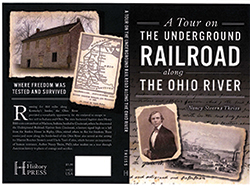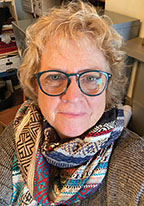




On the Trail
La Grange's Theiss pens book
on her Underground Railroad tour
The book examines areas from Evansville, Ind.,
to Maysville, Ky.
LA GRANGE, Ky. (February 2021) – Delia Webster’s story is just one of many fascinating accounts of individual bravery and heroism in the efforts to help slaves escape to freedom. There are many other stories of the conductors on the Underground Railroad as well as the individual efforts of slaves risking their lives to travel to free states.
Nancy Stearns Theiss grew up in the La Grange, Ky., area of Oldham County, but it was not until she became the executive director of the Oldham County History Center in 2004 that she became aware of all the slavery that was part of Oldham County’s past. She found thousands of papers on slavery in the Oldham County court records stored at the History Center.
“It was a real shock,” Theiss said.
 |
Photo provided Nancy Theiss last year published this book on her tour of the Underground Railroad sites and activities that took place along the Ohio River. |
After years of research, Theiss compiled her findings about river towns, the slave trade, the abolitionists and the Underground Railroad into a new book, “A Tour on the Underground Railroad along the Ohio River.” She started that research in 2005 by assembling an African American Committee of individuals interested in exploring local black history. They started by looking for names of those who had been enslaved locally.
They found the story of Henry Bibb through online resources. At that time in La Grange, very few local people were aware of Bibb. They learned that he had been enslaved and lived on property called Gatewood, which is in nearby Bedford, Ky. In 1849, Bibb had published a book titled, “The Life and Adventures of Henry Bibb: An American Slave.” That Gatewood property is now owned by Glenn Fisher. With Fisher’s permission, archaeology programs and digs have been conducted by the Oldham County Historical Society.
Theiss continued to compile the stories of individuals, both slave and free, their cities, the daring escapes and anti-slavery activities in those locations.
The common thread was the Ohio River. Theiss pointed out that the Ohio River provided 664 miles of opportunity from the slave state of Kentucky to free states: Indiana, Illinois and Ohio.
There was a natural flow to the stories, following the Ohio River from Evansville, Ind., on the west, to Cincinnati, and then on as far as Maysville, Ky. Theiss wanted to see it all.
In September 2018, she organized a tour. “There were about eight to 10 of us. We rented a few vans and took off. That tour was the thing that inspired me to write a book. I decided to write a tour book about the most significant sites to visit. When you visit the sites, you feel it more. You can see the surroundings and understand what it must have been like. Back then, the river was so much smaller.
 |
Theiss |
“During severe droughts, you could walk across the river near Madison. People knew about the shallow places where barges would get stuck. Some places there were weeds and river grasses that made good hiding places,” Theiss said.
In addition to Webster, other conductors in the Madison area included George DeBaptiste, Elijah Anderson and Chapman Harris. Madison was also the site of Henry Bibb’s first escape.
Theiss provides the written descriptions of each location for a DIY version of her original tour. She includes the amazing stories of carefully planned escapes, aided by individuals like Levi Coffin (called the Father of the Underground Railroad), his wife, Catherine, and many other passionate abolitionists. The places come alive as the stories unfold along the river. The best part is that any part of the tour can be completed as a short day trip. It is not limited to any particular season.
Slaves sought freedom anytime, anywhere, braving weather, treacherous waters and slave-hunting sheriffs. At any time, in any of the locations described in the book, one can stand in the rain, the hot sun, the fog or the snow and imagine what it would be like to cross the river or that terrain on such a day.
The book is organized with five chapters that describe localized tours. Large cities have the advantage of museums and formal exhibits, such as the Muhammad Ali Center and Kentucky Center for African American History in Louisville and the National Underground Railroad Freedom Center in Cincinnati. An exhibit there includes a slave jail dismantled in Mason County, Ky., and re-assembled at the Freedom Center.
Smaller towns and rural areas provide the experience of how far it was to walk and how difficult it was to hide without being discovered. Jan Vetrhus, Board President of the Eleutherian College in Lancaster, Ind., just north of Madison, worked with Theiss to identify key locations and routes in the Madison area. “When you walk uphill in a creek bed, you experience how difficult it is, remembering also that fugitive slaves walked that creek bed at night,” Vetrhus said.
“There are places along the river that are so beautiful and still natural, especially between Cincinnati and Ripley, Ohio,” Theiss said. “The ferry which started in 1798 in Augusta, Ky., still operates daily from 8 a.m. to 5 p.m.”
All of the significant sites have markers or information onsite about the history of that location. The pandemic has created more interest in local travel opportunities. This tour guide is a convenient resource for a day trip close to home while gaining a new appreciation for the stories about the Underground Railroad in our communities. The book is available at the Oldham County History Center and on Amazon.com.